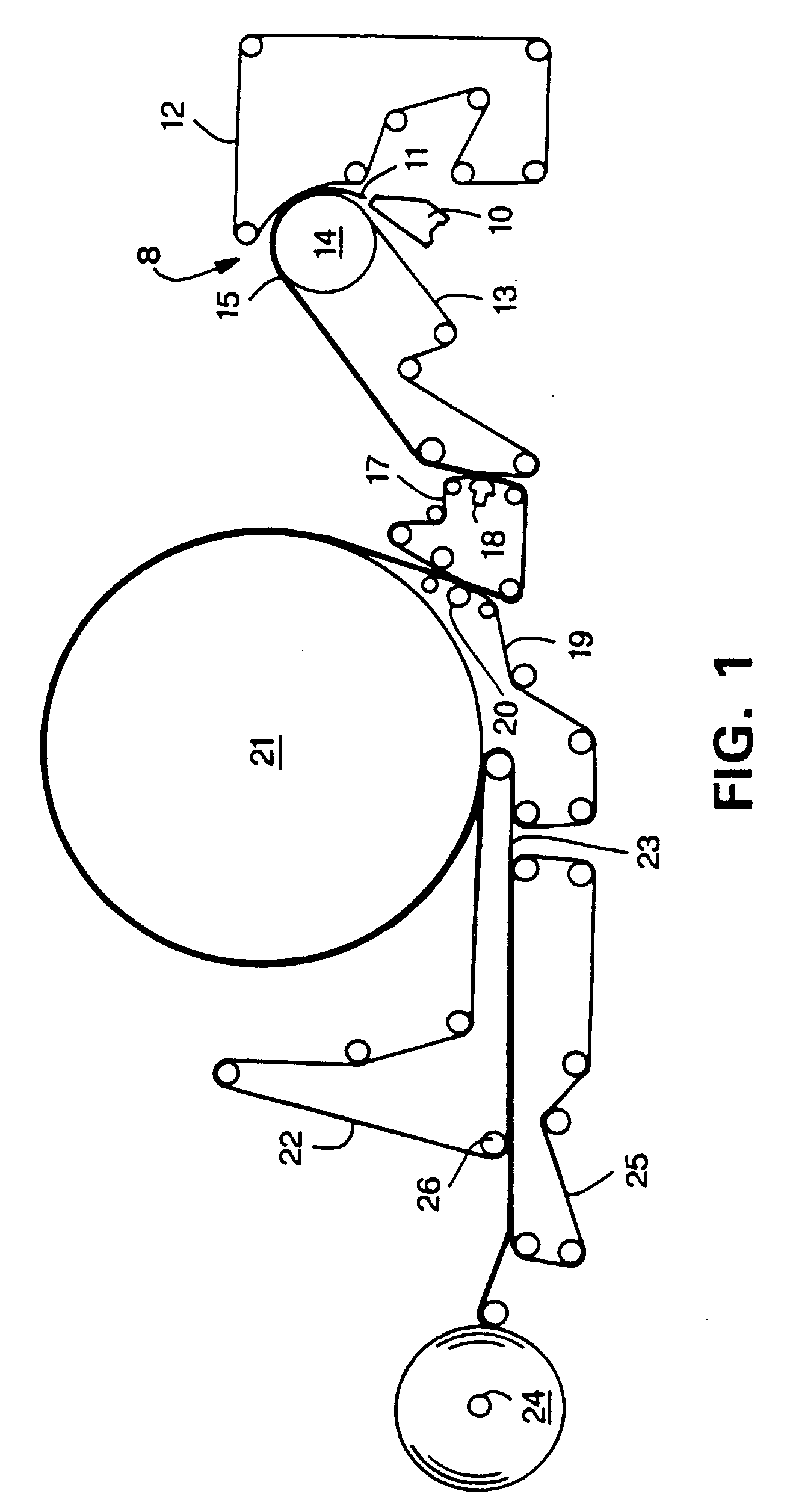Soft Single-Ply Tissue
a single-ply, soft technology, applied in the field of soft single-ply tissue, can solve the problems of providing significant cd strain and affecting the uniformity of strain across the sheet, and achieve the effects of high cross-machine direction (cd) stretch, low stiffness, and high base weigh
- Summary
- Abstract
- Description
- Claims
- Application Information
AI Technical Summary
Benefits of technology
Problems solved by technology
Method used
Image
Examples
example 1
Invention
[0062]A tissue sheet was produced as described above, but using a textured throughdrying fabric. Specifically, the textured throughdrying fabric was a Voith Fabrics “Jack” t1207-12 fabric as described in Table 1 of Mullally et al., previously incorporated by reference. The textured throughdrying fabric had a CD path length of about 1.6. The textured transfer fabric was a Voith Fabrics “Jetson” t1207-6 fabric as described in Table 1 of Mullally et al. The textured transfer fabric had CD path length of about 1.6. The resulting basesheet had the following properties: bone dry basis weight, 43.7 gsm; 1-sheet caliper, 0.0289 inch (0.73 mm); and sheet bulk, 16.8 cc / g.
[0063]The basesheet was then calendered as described above. The Compression Energy applied to the basesheet was 1.06 N mm / mm2.
[0064]The resulting calendered tissue sheet had the following properties: basis weight, 40.6 gsm; sheet caliper, 0.0155 inch (0.39 mm); sheet bulk, 9.7 cc / g; GM Slope, 7.57 kg per 76.2 mm samp...
example 2
Invention
[0066]A tissue sheet was produced as described in Example 1 above, but using a different textured transfer fabric. The textured transfer fabric was a Voith Fabrics t807-1 fabric, which had CD path length of about 1.4. The resulting basesheet had the following properties: bone dry basis weight, 44.1 gsm; 1-sheet caliper, 0.0283 inch (0.72 mm); and sheet bulk, 16.3 cc / g.
[0067]The basesheet was then calendered as described above. The Compression Energy applied to the basesheet was 0.39 N mm / mm2.
[0068]The resulting calendered tissue sheet had the following properties: basis weight, 42.1 gsm; sheet caliper, 0.0159 inch (0.40 mm); sheet bulk, 9.6 cc / g; GM Slope, 7.99 kg per 76.2 mm sample width; MD tensile strength, 1236 grams per 76.2 mm sample width; CD tensile strength, 814 grams per 76.2 mm sample width; GMT, 1003 grams per 76.2 mm sample width; CD stretch, 6.57 percent; GM Slope / GMT, 7.96; CD TEA / CD tensile, 7.0; exponential compression modulus, 7.5; breaking length, 313 met...
example 3
Comparative
[0070]A tissue sheet was produced as described in Example 1 above, but using a non-textured throughdrying fabric. Specifically, the throughdrying fabric was a Asten Johnson 934 throughdrying fabric installed with the long warps to the sheet and having a CD path length of about 1.0. The resulting basesheet had the following properties: basis weight, 44.24 gsm; sheet caliper, 0.0207 inch (0.53 mm); and sheet bulk, 11.9 cc / g.
[0071]The basesheet was then calendered as described above. The Compression Energy applied to the basesheet was 0.34 N mm / mm2, which was lower than that of Example 1, partially because of the lower bulk (caliper) of the basesheet being calendered.
[0072]The resulting calendered tissue sheet had the following properties: basis weight, 42.5 gsm; sheet caliper, 0.0136 inch (0.35 mm); sheet bulk, 8.1 cc / g; GM Slope, 10.68 kg per 76.2 mm sample width; MD tensile strength, 1223 grams per 76.2 mm sample width; CD tensile strength, 838 grams per 76.2 mm sample wi...
PUM
| Property | Measurement | Unit |
|---|---|---|
| breaking length | aaaaa | aaaaa |
| height | aaaaa | aaaaa |
| height | aaaaa | aaaaa |
Abstract
Description
Claims
Application Information
 Login to View More
Login to View More - R&D
- Intellectual Property
- Life Sciences
- Materials
- Tech Scout
- Unparalleled Data Quality
- Higher Quality Content
- 60% Fewer Hallucinations
Browse by: Latest US Patents, China's latest patents, Technical Efficacy Thesaurus, Application Domain, Technology Topic, Popular Technical Reports.
© 2025 PatSnap. All rights reserved.Legal|Privacy policy|Modern Slavery Act Transparency Statement|Sitemap|About US| Contact US: help@patsnap.com



